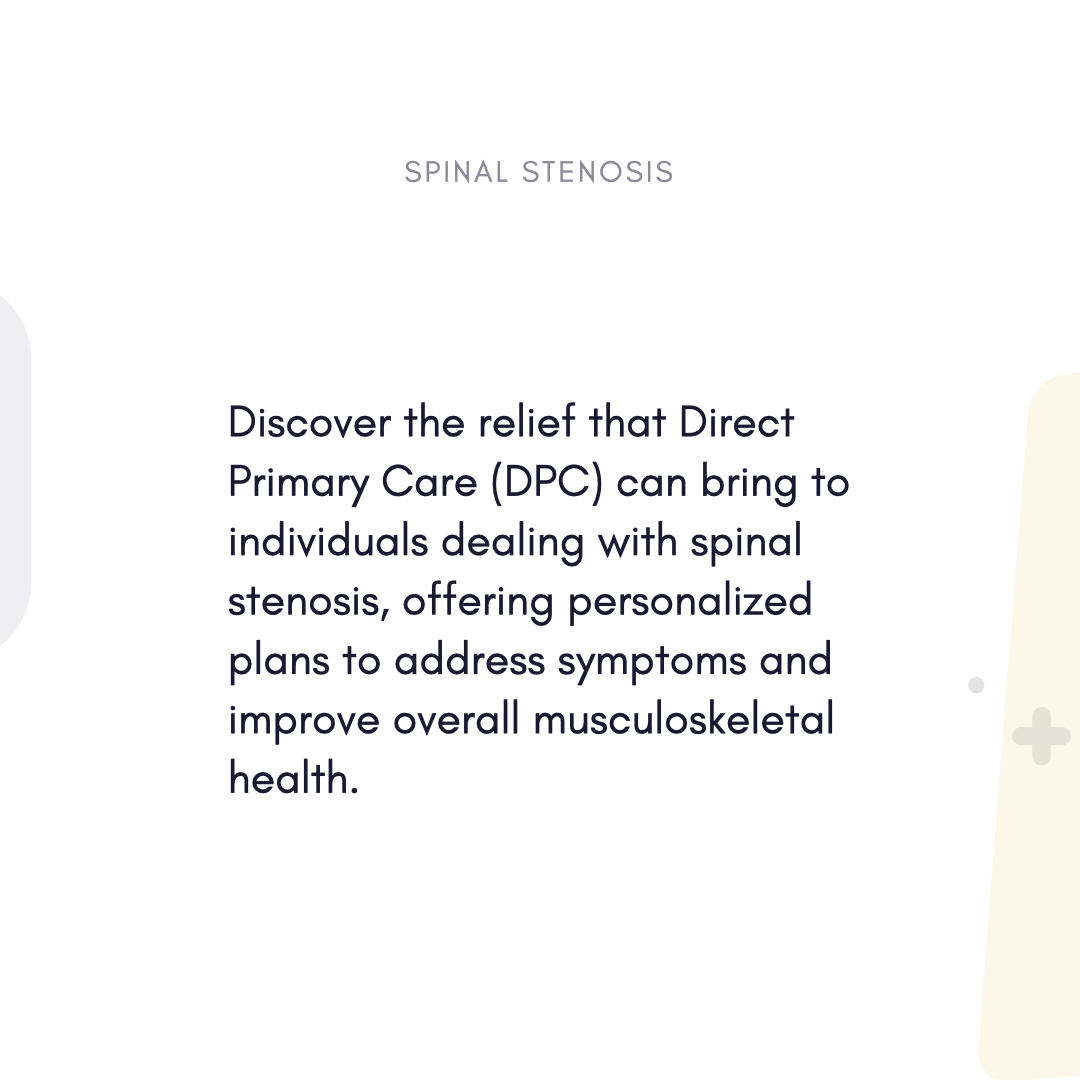Spinal Stenosis and Direct Primary Care (DPC): Personalized Relief for Chronic Back Pain
You know the toll of spinal stenosis if you have ever experienced a sharp ache radiating down your legs after too much standing, battled numbness while walking, or been sidelined by chronic lower back pain. Over 250,000 Americans suffer from this disorder every year; it usually results in limited mobility and a poor quality of life. Direct Primary Care (DPC), which combines timely interventions, cost transparency, and care catered to your particular need, presents a patient-centered method of spinal stenosis management, though.

Know Spinal Stenosis and Its Effects
When the spaces within the spine narrow and compress nerves, spinal stenosis results. Typical causes consist in:
- Declared changes: degenerative Arthritis; bone spurs; thickened ligaments.
- Bulging discs straying on spinal nerves.
- Naturally limited spinal canals are a congenital feature.
Location determines the variation in symptoms:
- Stenosis of the lumbar spine: Leg numbness, sciatica-like pain, neurogenic claudication—a weakness.
- Cervical stenosis causes balance problems, tingling in arms and hands, neck pain.
Long-term consequences of uncontrolled stenosis:
- Either chronic nerve damage or loss of bladder/bowel control (cauda equina syndrome).
- Less mobility causes muscular atrophy.
- Growing dependence on opioids to control pain.
DPC Changes Spinal Stenosis Management
Under the membership model known as Direct Primary Care (DPC), patients pay a monthly fee—usually 50 USD–150 USD—for unlimited access to their main care physician. For those with spinal stenosis, this means no surprise bills, no waiting weeks for visits, and treatment concentrated on restoring your mobility and comfort.
Here's why DPC distinguishes itself:
1. Timely, Guideline-Driven diagnosis
Following American Academy of Orthopaedic Surgeons' guidelines, DPC doctors do:
- In-depth assessments Using physical tests like the straight-leg raise, differentiating stenosis from like conditions (such as peripheral artery disease).
- Cost-effective imaging: Ordering MRIs or CT scans just when needed helps to avoid overtesting typical in conventional treatment.
- Prescription physical therapy (PT) or epidural steroid injections will help to postpone surgery.
2. Reasonably priced, open treatment
- By providing wholesale-priced generic NSAIDs (such as naproxen) or muscle relaxants, DPC clinics help to lower costs.
- For discounted cash-pay rates, teaming with nearby physical therapists.
- Steer clear of needless specialist referrals (conservative treatment helps to avoid 40% of spinal surgeries).
3. Constant, All-Inclusive Assistance
- Having 24/7 access to your DPC doctor allows you to change pain management strategies during flare-ups—that is, rotate medications to prevent tolerance.
- Track improvement using telehealth check-ins or mobility notebooks.
- Treat related conditions including obesity or osteoporosis that aggravate stenosis.
DPC Benefits for Patients with Spinal Stenosis
Customized Treatment Plans
- During each visit, DPC doctors dedicate 30 to 60 minutes developing plans including:
- Aimed for PT routines: Aquatic treatment or core-strengthening exercises to lower nerve pressure.
- Modifications in lifestyle: anti-inflammatory diets high in turmeric and omega-3s or posture correction for desk workers.
- Combining topical lidocaine patches with yoga or acupuncture provides multimodal pain relief.
Saving Money
- There are no co-pays for quick visits during acute pain episodes.
- MRIs between 500 USD and 800 USD against 2,000 USD+, in conventional settings.
- Prevention of ER visits by means of aggressive symptom control.
Medical Stewardship: Surgery
Should surgery become absolutely necessary, DPC doctors:
- Plan discounted neurosurgery consultations in concert.
- Promote least invasive choices (such as laminectomy against fusion).
- Track recovery to avoid problems including scar tissue.
Personal Success Stories from Real Life
- Case 1: 68-year- Linda skipped lumbar stenosis surgery. Her DPC doctor wrote a 12-week PT schedule and gabapentin prescription to help her walk pain-free.
- Case 2: Using negotiated rates from his DPC clinic, James, 55, saved 1,200 USD on epidural injections to treat cervical stenosis without opioids.
Questions and Answers: Spinal Stenosis and DPC
- Q: Is spinal stenosis reversible without surgery?
- A: Although changes in anatomy are permanent, cornerstones of DPC management—PT, weight loss, and anti-inflammatory treatment usually help symptoms improve.
- Q: DPC sounds reasonable for persistent back discomfort.
- A: Indeed. By skipping imaging mark-ups and specialist co-pays, members save 30–50% yearly.
- Q: Suppose I need a spine specialist?
- A: A DPC physician usually gets self-pay discounts for consultations and speeds referrals.
Why DPC Benefits Those With Spinal Stenosis
The American College of Physicians notes DPC's capacity to use continuity and trust to enhance outcomes for chronic diseases. In terms of stenosis, this implies:
- Early PT lowers 60% of the disability risks.
- Tackling root causes like inflammation addresses not only symptoms but also holistically.
- Clear financial statements for visits, medications, and tests.
Take Back Your Movement with DPC.
Spinal stenosis need not restrict your life. DPC helps you find a partner who listens, creative thinker, and gives your freedom of movement—step by step top priority.






